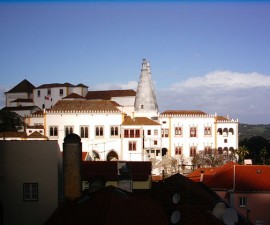Portugal is famous for its protected parks and natural areas, boasting a national park, thirteen natural parks, several natural reserves and monuments and a number of protected landscapes.
The Sintra-Cascais Natural Park is one of Portugal’s thirteen designated Natural Parks and stretches from the coast at Cascais up to the Cabo da Roca, Europe’s westernmost point, across the flat plane behind the coastline and up through the Sintra mountains to meet the town of Sintra itself.
The area has been protected since 1981 and it earned its official designation as a Natural Park in 1994 from the Portuguese Government. In total the Sintra-Cascais Natural Park covers an area of 145 km2. Thanks to its location just 30km west of Lisbon and the popularity of Cascais and Sintra as tourist destinations in their own right, it is a popular area for exploration and adventure by visitors from all over Portugal, Europe and beyond.
A fascinating combination of nature and nurture
The Sintra-Cascais Natural Park is notable for its wide range of landscapes in comparison to its relatively small size, leading UNESCO to classify part of it as a World Heritage Landscape and the European Union to place much of it under its Habitats Directive as a site of community importance. It offers a unique combination of and sea, of beautiful natural scenery and of enchanting architectural heritage.
This is an area where the rugged coastline is licked by gentle crystalline waters in a sheltered cove to one side and buffeted by huge Atlantic rollers to the other, where the spires of baroque palaces and escarpments of military castles preside over the lush greenery of the mountain landscape mixing old and new, nature and nurture.
The Park is roughly divided into two parts – the coastal area which is characterised by beaches, cliffs and dunes and flanked by the pine woods that rise away from the water, and the agricultural area which is a major fruit and wine producing area as well as producing horticultural products.
Our Nature tour works its way north east around the coast from Cascais taking in various well known natural landmarks along the way before climbing away from the coast, across the flat plain and up the Sintra mountain to the UNESCO World Heritage Sites of Sintra town itself.
Admire the strength of the Atlantic Ocean at the Boca do Inferno
The first stop on the coastal tour from Cascais is at the Boca do Inferno. Literally meaning “Devil’s Mouth”, Boca do Inferno is a natural phenomenon occurring at the point where a rock formation meets the Atlantic waves. The waves literally erupt through a small hole, bursting out on the other side with a dramatic flourish. Conditions are best at mid tide when the waves are large enough to create drama but not so large that they close off the pathway and force one to observe from afar.
Next stop is Cabo Raso, several kilometres further up the coast. Cabo Raso is topped by a lighthouse and the Forte de São Bras de Sanxete, which preside over this rocky stretch of coastline, originally constructed both to protect the land from external threats and passing ships from its treacherous rocky outcrops. If you are lucky enough to be here at sunset, the views from Cabo Raso as the sun dips over the water and behind the horizon are a delight on all but the cloudiest or days.
From Cabo Raso we make our way to Guincho, the widest stretch of beach in the area, backed by wild dunes and flanked by rocks either side of its large expanse. Guincho is the perfect spot for a relaxed lunch during your nature tour at one of the delicious seafood restaurants that sit in an idyllic position, perched above the beach.
If you continue north up the coast from here, you will arrive at the Cabo da Roca, mainland Europe’s westernmost point. Cabo da Roca comprises some dramatic high cliffs and rock formations that fall away sharply to the wild seas below.
Alternatively, heading inland across the plain one can appreciate the natural beauty of the area, tempered only by agricultural activity and several golf courses that have established themselves here over the decades. The landscape then rises to an altitude of 529m at Cruz Alta, surrounded by a series of climatic and geographic phenomena that create some unique natural conditions.
If your itinerary allows, this is the perfect spot to indulge in walking, trekking, horse riding, mountain biking, climbing or abseiling and there are several operators and guides in the area. For up-to-date details contact the tourist office in Cascais on your arrival. Finish your trip basking in the views of the final ascent to Sintra before going on to explore this delightful hilltop town, steeped in history and grandeur.

